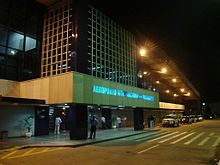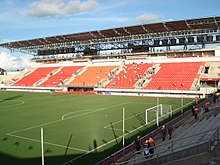| Revision as of 00:35, 6 December 2007 editOpinoso (talk | contribs)7,395 edits No Italian immigration to Acre← Previous edit | Revision as of 00:35, 6 December 2007 edit undoOpinoso (talk | contribs)7,395 edits No Carnival or Festa Junina in AcreNext edit → | ||
| Line 87: | Line 87: | ||
| * União Educacional do Norte (Uninorte). | * União Educacional do Norte (Uninorte). | ||
| ==Culture== | |||
| ===] (Saint John Festival)=== | |||
| ] in Saint John Festival.]] | |||
| ] was introduced to Northeastern ] by the ] for whom St John's day (also celebrated as ] Day in several ]an countries), on the 24th of June, is one of the oldest and most popular celebrations of the year. Differently, of course, from what happens on the European ] Day, the festivities in Brazil do not take place during the ] but during the tropical ]. The festivities traditionally begin after the 12th of June, on the eve of St Anthony's day, and last until the 29th, which is Saint Peter's day. During these fifteen days, there are ], ], and folk dancing in the streets (step names are in French, which shows the mutual influences between court life and peasant culture in the 17th, 18th, and 19th-century Europe). Once exclusively a rural festivity, today, in Brazil, it is largely a city festival during which people joyfully and theatrically mimic peasant stereotypes and cliches in a spirit of joke and good time. Typical refreshments and dishes are served. It should be noted that, like during Carnival, these festivities involve costumes-wearing (in this case, peasant costumes), dancing, heavy drinking, and visual spectacles (fireworks display and folk dancing). Like what happens on ] and St John's Day in Europe, ] are a central part of these festivities in Brazil. | |||
| ===Carnival=== | |||
| The four-day period before Lent leading up to Ash Wednesday is ] time in ]. Rich and poor alike forget their cares as they party in the streets. | |||
| == Infrastructure == | == Infrastructure == | ||
Revision as of 00:35, 6 December 2007
- For other meanings of the word Acre, see also: Acre (disambiguation)
Template:Infobox Brazilian State
Acre (IPA: [ˈakɾi]) is a state of Brazil, located in the north-western part of the country. To the north is the state of Amazonas, to the east is a short border with the state of Rondônia, to the south is Bolivia and to the west is the Ucayali Region of Peru. Today, only a small part of the inhabitants survive from the extration of the latex. Other products of the forest have gained fame: açaí is very appreciated in the center-south of Brazil, the "folha de pimenta longa", long pepper leaf, used to manufacture natural perfumes and hair products, natural food and medicines.
Geography

Acre has a territory covered mostly by jungle of the Amazon Rainforest. The state is a well-known producer and exporter of rubber. The Acre River runs along the southern boundary of the state, forming the border with Bolivia.
Climate
An equatorial climate is a type of tropical climate in which there is no dry season – all months have mean precipitation values of at least 60mm. It is usually found at latitudes within five degrees of the equator – which are dominated by the Intertropical Convergence Zone. The equatorial climate is denoted Af in the Köppen climate classification. Tropical rainforest is the natural vegetation in equatorial regions.

Vegetation
The Amazon represents over half of the planet's remaining rainforests and comprises the largest and most species-rich tract of tropical rainforest in the world. Wet tropical forests are the most species-rich biome, and tropical forests in the Americas are consistently more species rich than the wet forests in Africa and Asia. As the largest tract of tropical rainforest in the Americas, the Amazonian rainforests have unparalleled biodiversity. More than 1/3 of all species in the world live in the Amazon Rainforest.
History



The territory was assigned to Bolivia in 1867 by the Treaty of Ayacucho with Brazil. In 1899-1900, the Spanish journalist and former diplomat Luiz Galvez Rodrigues de Aria led an expedition that sought to seize control of what is now Acre from Bolivia. The expedition was secretly financed by the Amazonas state government and aimed to incorporate Acre into Brazil after its independence from Bolivia. Galvez declared himself president of the first Republic of Acre on July 14 1899. That first republic lasted until March 1900, when the Brazilian government sent troops to arrest Galvez and give Acre back to Bolivia. Galvez was deported to Spain and the inhabitants of Acre saw themselves against Bolivia and Brazil. In spite of a second attempt at creating an Acre Republic (November 1900 - December 24 1900), Acre remained part of Bolivia until 1903. After the failure of the second attempt to seceed Acre from Bolivia, a veteran soldier from Rio Grande do Sul who had fought in the Federalist Revolution of 1893, José Plácido de Castro, was approached by the Acrean Revolution leaders and offered the opportunity to lead the independence movement against the Bolivians. Plácido, who had been working in Acre since 1899 as a chief surveyor of a surveying expedition and was about to go back to Rio de Janeiro, accepted the offer. He imposed strict military discipline and reorganized the revolutionary army, which reached 30.000 men. The Acrean army won battle after battle and on January 27, 1903, José Plácido de Castro declared the Third Republic of Acre. President Rodrigues Alves of Brazil, ordered Brazilian troops into Northern Acre in order to replace Plácido as the president of Acre. Through Rodrigues Alves' most able minister's diplomacy, Barão do Rio Branco, the question was settled. After negotiations a treaty was signed. The Treaty of Petrópolis, which was signed on November 11 1903, gave Brazil Acre (191.000 km²) in exchange for lands in Mato Grosso, payment of two million pounds sterling and an undertaking to construct the Madeira-Mamoré railroad that would allow Bolivia access to the outside world. It should be noted that for forty years, since around 1860, Acre had been overrun by Brazilians, who made up 99% of the population. On February 25, 1904 it was officially made a federal territory of Brazil, and a federal state in 1962. Acre is best known for being the home of the rubber tapper Chico Mendes, who was murdered at the orders of powerful cattle ranchers in 1988.
Demographics
Ethnic groups

According to the IBGE of 2007, there were 664.000 people residing in the state. The population density was 4,5 inh./km². The last PNAD (National Research for Sample of Domiciles) census revealed the following numbers: 441 thousand Pardo people (66.5%), 172 thousand White (26.0%), 45 thousand Black (6.8%), 4 thousand Asian or Amerindian people (0.7%).
The majority of the Whites of the state is of Portuguese descent. The Pardos are a mixture of Europeans with the Blacks and/or Amerindians, varying from light to dark complexion. The Blacks are of African descent.
Urbanization: 68.4% (2004); Population growth: 3.3% (1991-2000); Houses: 162.617 (2005).
Source: PNAD.
Economy
The service sector is the largest component of GDP at 66%, followed by the industrial sector at 28.1%. Agriculture represents 5.9%, of GDP (2004). Acre exports: wood 85.6%, meat of chicken and wild turkey 4.7%, products of wood 1.7% (2002).
Participation in the Brazilian economy: 0.2% (2004).
Curiosity
Vehicles: 73.782 (jan./2006); Mobile phones: 260 thousand (2006); Telephones: 99 thousand (2006); Cities: 22 (2006).
Education

Portuguese is the official national language, and thus the primary language taught in schools. But English and Spanish are part of the official high school curriculum.
Colleges and Universities
- Universidade Federal do Acre (Ufac);
- Faculdade da Amazônia Ocidental (Faao);
- Faculdade de Ciências Jurídicas e Sociais Aplicadas Rio Branco (Firb);
- Instituto de Educação, Ciência e Tecnologia do Vale do Juruá (Ieval);
- Instituto de Ensino Superior do Acre (Iesacre);
- União Educacional do Norte (Uninorte).
Infrastructure
International Airport

Rio Branco International Airport is located in a rural zone of the municipality of Rio Branco, in the state of Acre. It was opened on November 2, 1999 with a unique characteristic: it moved 22 kilometers from the previous airport site. Rio Branco Airport serves domestic and international flights (by scheduled carriers and air taxi firms) along with general and military aviation. The terminal can receive 270 thousand passengers a year and serves an average of 14 daily operations.
Cruzeiro do Sul International Airport is locate 18 kilometers from the city center, which helps access to the Alto Juruá region. It was opened on October 28, 1970 and absorbed by Infraero on March 31, 1980. The airport infrastructure was built in 1976 by the municipal government. In 1994 the runway was totally renovated.
Highways
- BR-364 (Rio Branco to Rondônia);
- BR-317 (Rio Braco to south of Acre);
- AC-040 (Rio Branco to Plácido de Castro);
- AC-401 (Plácido de Castro to Acrelândia);
- AC-010 (Rio Branco to Porto Acre).
Sports

Rio Branco provides visitors and residents with various sport activities.
- Stadiums
- Arena da Floresta stadium;
- José de Melo stadium;
- Federação Acreana de Futebol stadium;
- Dom Giocondo Maria Grotti stadium;
- Adauto de Brito stadium;
- and many others.
Rio Branco is one of the 18 remaining candidates to host games of the 2014 FIFA World Cup, for which Brazil is the only South American bidder.
Indigenous population
Acre is inhabited by various indigenous groups of the Panoan language family, including Kashinawa, Jaminawa and Xanenawa. There are also three groups of other language families, Madiha (Kulina) of the Arawan family as well as Yine (Manchineri) and Ashaninka (Kampa) of the Arawakan family.
Flag
The flag was adopted on March 15, 1921. It is a variation of the flags used by the secessionist state of Acre, with the yellow and green parts exchanged and mirrored. The yellow color symbolizes peace, green hope, and the star symbolizes the light which guided those who worked to make Acre a state of Brazil.
References
- The presented pronunciation is in Brazilian Portuguese. The European Portuguese pronunciation is: /'a.kɾɨ/.
- Turner, I.M. 2001. The ecology of trees in the tropical rain forest. Cambridge University Press, Cambridge. ISBN 0-521-80183-4
- Amazon Rainforest, Amazon Plants, Amazon River Animals
- Síntese de Indicadores Sociais 2007 (PDF) (in Portuguese). Acre, Brazil: IBGE. 2007. ISBN 85-240-3919-1. Retrieved 2007-07-18.
- List of Brazilian states by GDP (PDF) (in Portuguese). Acre, Brazil: IBGE. 2004. ISBN 85-240-3919-1. Retrieved 2007-07-18.
See also
- Template:En icon Brazil
- Template:Pt icon Official Website
- Template:En icon Brazilian Tourism Portal
- Template:Pt icon Acre's location on a 3D globe (Java)
| Regions and states of Brazil | |||||||||||
|---|---|---|---|---|---|---|---|---|---|---|---|
| Federative units |
| ||||||||||
| Notable archipelagos | |||||||||||
| Socio-geographic divisions | |||||||||||